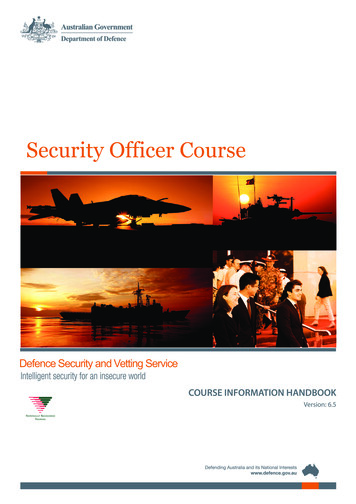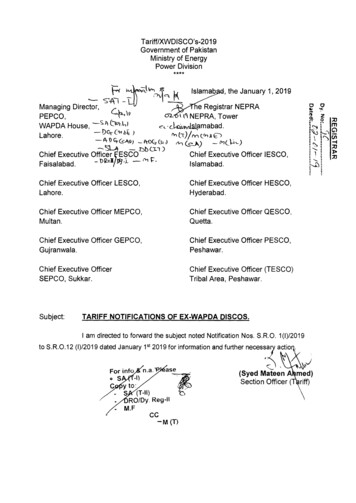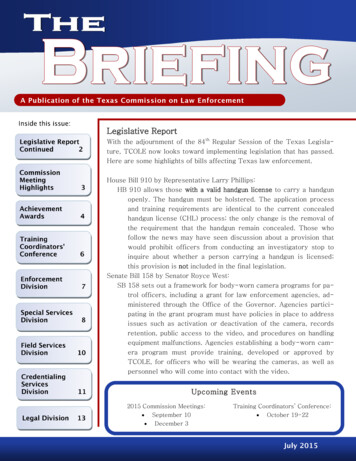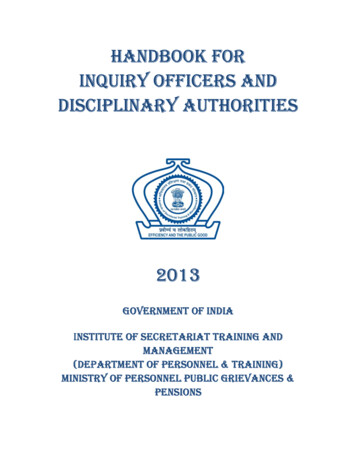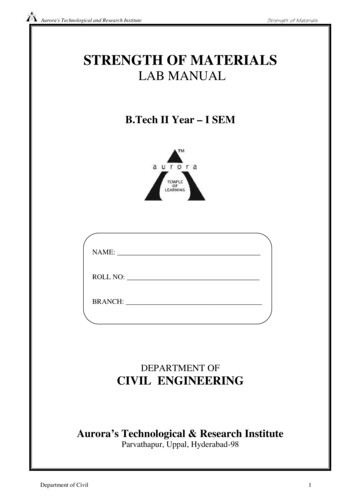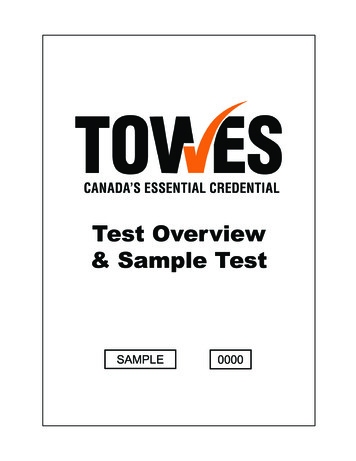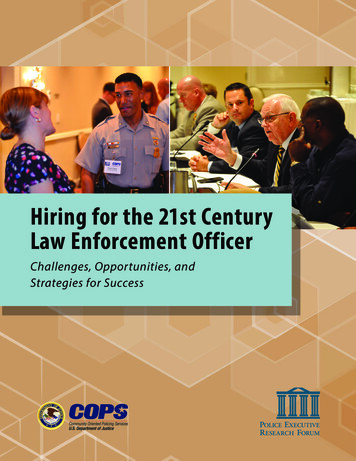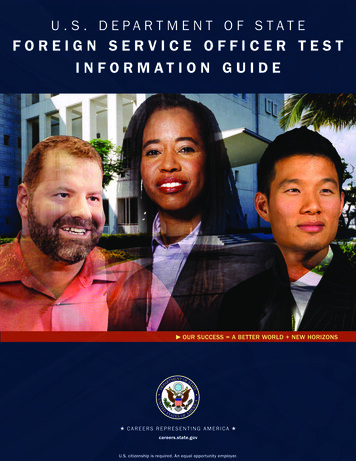
Transcription
U . S . D E PA R T M E N T O F S TAT EFOREIGN SERVICE OFFICER TESTI N F O R M AT I O N G U I D EOUR SUCCESS A BETTER WORLD NEW HORIZONSU.S. citizenship is required. An equal opportunity employer.
Information Guide to theForeign Service OfficerSelection ProcessINTRODUCTION . 1What is the Foreign Service Officer Selection Process? . 1Purpose and Use of this Guide . 2What is the FSOT? . 2Test Dates . 2Disability Accommodations. 28 STEPS TO A FOREIGN SERVICE CAREER . 3Step 1: Choose a Career Track. 3Step 2: Register for the FSOT . 3Step 3: Take the FSOT . 5On the Day of the Test . 5Procedures at the Test Center. 6Computer-Based Testing Procedures . 7What to Expect During the FSOT . 7FSOT Knowledge and Skill Areas . 9Related Areas of Study . 10Once the Test Session is Over . 11Step 4: Submit Personal Narratives for QEP Review .12Step 5: Take the Oral Assessment .14Before the Oral Assessment . 14Oral Assessment Procedures . 15The Oral Assessment . 17Step 6: Obtain Security and Medical Clearances .21Step 7: Pass the Suitability Review .21Step 8: Go On The Register .22FSOT Non-Disclosure Agreement .23FSOA Non-Disclosure Agreement.23SAMPLE FSOT JOB KNOWLEDGE QUESTIONS . 24SAMPLE FSOT BIOGRAPHIC QUESTIONAIRE ITEMS . 28SAMPLE FSOT ENGLISH EXPRESSION QUESTIONS . 29SAMPLE FSOT WRITTEN ESSAY TOPICS . 39SAMPLE FSOA GROUP EXERCISE . 40SAMPLE FSOA STRUCTURED INTERVIEW HYPOTHETICALSCENARIOS . 64SAMPLE FSOA CASE MANAGEMENT EXERCISE . 65SUGGESTED REFERENCE MATERIALS . 83
Every attempt has been made to ensure the accuracy of this publication. If, however, youshould find any discrepancy between the information here and the information oncareers.state.gov, please assume that the website has the most accurate and up-to-dateinformation. If you have any questions or comments about this Guide, please write to:Information Guide to the Foreign ServiceOfficer Selection ProcessHuman Resources Research Organization66 Canal Center Plaza, Suite 700Alexandria, VA 22314-1591 2016 by HumRRO All rights reserved.66 Canal Center Plaza, Suite 700, Alexandria, VA 22314-1591No part of this publication may be copied, reproduced or distributed in any form, including withoutlimitation through electronic networking, distribution or retrieval systems, without the prior writtenpermission of HumRRO.
INTRODUCTIONWhat is the Foreign ServiceOfficer Selection Process?In other words, it is a hiring process. Therefore, thenature and purpose of this assessment process aredifferent from those of educational testing.The Foreign Service Act of 1980 tasks the U.S.Department of State – and the Board of Examiners(BEX) specifically – with responsibility for theevaluation and selection of candidates for theForeign Service.In education, assessment focuses on “masterytesting” and the goal is to determine if the studentpossesses sufficient knowledge or skill to pass acourse or to practice a profession. The assessmentsare usually comprehensive, covering the entire bodyof required knowledge or skill. The scores verifycurrent competence and command of a definite skillset. Such assessments are often accompanied byextensive feedback, and possibly remedial trainingand reassessment, with the ultimate objective ofpassing. Education assessments are not acompetition; the objective is for everyone to pass.The Department takes this charge seriously and hasdevoted significant resources to the development ofa Foreign Service Officer Selection Process withthe goal of providing all candidates, regardless ofsocioeconomic background, education, orexperience, a chance to demonstrate their potentialto be a Foreign Service Officer.In employment selection, the goal is to determinewhich candidates are the most qualified because anorganization wants to hire the best. Employmentassessments only sample a job-related body ofknowledge or skills because assessment time islimited. The scores are used as predictors ofprospective job performance, rather than indicatorsof current competence. Thus, tests like those used inthe Foreign Service Officer selection process are notaccompanied by extensive feedback or remedialtraining because they are not meant to measure anentire body of knowledge or skills. Moreover, theorganization’s hiring process is meant to be highlyselective given the limited number of openingsavailable.Candidates who participate in the selection processwill find that it is designed to challenge them and togive them the opportunity to demonstrate qualitiesthat have been identified as necessary to become asuccessful Foreign Service Officer. Thus, theBoard of Examiners stands by the validity andintegrity of the assessment process as being a fairand accurate selection method for Foreign ServiceOfficers. Indeed, it is vital to the U.S. Departmentof State’s mission and purpose.To ensure no bias in favor of any candidate, theBoard of Examiners periodically revises its testingmaterials. It also asks all candidates to sign nondisclosure agreements before beginning portions ofthe assessment, and has implemented othersafeguards. Please note that BEX will terminate thecandidacy of anyone found to have violated the nondisclosure agreement.ALERT: Candidates should thoroughly read theEight Steps to Becoming a Foreign ServiceOfficer on careers.state.gov before they submittheir applications.The Foreign Service is a unique career and, perhapsunsurprisingly, the selection process is also unique.The Foreign Service selection process, includingthe Foreign Service Officer Test (FSOT), theQualifications Evaluation Panel (QEP), and theForeign Service Oral Assessment (FSOA), is anemployment selection tool used by the Departmentof State to identify the most qualified candidates forForeign Service positions.1
This Guide provides sample questions for eachcomponent of the FSOT to give candidates ageneral idea of the type of questions they willencounter in the test.Purpose and Use of this GuideThe purpose of this Guide is to help familiarizecandidates with the selection and assessmentprocess so that they will be able to better focus ontheir own performance rather than spend theirlimited time reviewing procedures.Although the Written Essay section is an importantaspect of the test that is used to determine acandidate’s qualifications, it will not be scoredunless the candidate passes the Job Knowledge,Biographic Questionnaire, and English Expressionsections of the test.This introduction presents a brief overview of theFSOT, its components, and the testing process.Real-life stories from Foreign Service Officers arehighlighted in the left column throughout the Guide.Test DatesThe next section, titled Steps to Becoming aForeign Service Officer, discusses the eight stepsin the selection process and the qualifications thatmust be met to become a Foreign Service Officer.This section provides detailed instructions andprocedures to help inform candidates about theFSOT and FSOA. It explains the knowledge andskill areas covered on the tests, and it offers a list ofrelated academic areas of study.The computer-based FSOT, administered by thetesting firm Pearson VUE, is offered three timeseach year, in February, June and October. Forspecific dates and applicable deadlines, candidatesshould visit careers.state.gov orpearsonvue.com/fsot/. Each eight-day testingwindow offers multiple testing times. There is nolimit on the number of times an applicant may takethe FSOT, but the test can be taken only once in a12-month period.The Sample Question sections in the Guide aredesigned to familiarize candidates with the types ofitems that will appear on the Foreign ServiceOfficer Test and Foreign Service Oral Assessment.Candidates are informed about the content, length,format, and time limits for each section of theseassessments.The test is offered throughout the United States, atsome overseas Pearson Professional Centers, and atsome U.S. Embassies and Consulates.Disability AccommodationsWhat is the FSOT?All applicants, including those requestingreasonable accommodations, must submitapplications for the FSOT at pearsonvue.com/fsot/.In addition to preparing and administering theFSOT, Pearson VUE is responsible for allaccommodation requests for candidates withdisabilities, including those planning to test at anembassy or consulate.The Foreign Service Officer Test (FSOT) is the firstof eight steps in the FSO selection process. It is acomputer-based test that consists of four separatetest sections:1. Job Knowledge Test2. Biographic QuestionnaireThe accommodation approval process can belengthy. To allow sufficient time for approval andthe necessary arrangements, candidates must submitaccommodations requests in writing withaccompanying documentation to Pearson VUE nolater than the date that the registration windowopens. Follow the detailed instructions foraccommodations requests provided athttp://www.pearsonvue.com/accommodations.3. English Expression Test4. Written Essay TestThe first three sections of the test contain items in amultiple-choice format. The Written Essay appearsin the last section of the FSOT. Each section of thetest is timed separately and must be completedwithin the designated time limit.2
8 STEPS TO A FOREIGN SERVICE CAREERStep 2: Register for the FSOTThe FSOT is only one of the several steps in theselection process for becoming a Foreign ServiceOfficer. The eight steps involved in the selectionprocess are as follows:The registration process, which includes concurrentapplication submission and seat selection, opensapproximately five (5) weeks prior to each testingwindow. To register, candidates should go topearsonvue.com/fsot/ during the five-week periodprior to a specific testing window to create anaccount, submit completed eligibility verification andapplication forms, and select a location and seat forthat specific test date. The registration process closesthree (3) days before the testing window opens.A candidate’s Pearson VUE account shows theprogress on the five steps of the selection process thatPearson VUE manages, from application to OralAssessment appointments. The application comprisesseven sections: about you, military service, careertrack, education, language and proficiency, workexperience, and other personal information. Finally,candidates must certify that the information provided iscorrect before they will be able to submit theapplication. Remember that once the application issubmitted it cannot be changed and applications canonly be submitted during registration periods.Candidates who wish to update or change theirapplication information, including career track, maychoose not to take a particular test and submit a newapplication during the next registration window.Candidates will be assessed a fee of 72.00 forfailure to cancel an appointment at least 48 hoursbefore the FSOT test date or for failure to appearfor the test. Candidates cannot reserve a seat foranother testing date until any outstanding no-showfee has been paid.Step 1: Choose a Career TrackChoosing a career track during the registrationprocess is very important. Applicants should fullyeducate themselves about the five Foreign Servicecareers tracks: Consular, Economic, Management,Political, and Public Diplomacy, and take time tomake the best selection given their careeraspirations. Once an application is submitted, itcannot be changed and candidates are locked intothe chosen career track for the duration of thatcandidacy. The candidate may change career trackswhen submitting a new application.Candidates should keep in mind that they aresubmitting a job application that will follow themthroughout the selection process. They shouldcomplete their online application form with attentionto detail. This is the first form the QualificationsEvaluation Panel (QEP) will consider whenreviewing the files of candidates who pass theFSOT. It is also the one document, along with acandidate’s Statement of Interest, that assessors willreview before the Structured Interview on the day ofthe Oral Assessment.3
Candidates should keep personal information in theirprofiles up-to-date. Candidates are able to makesome changes themselves (e-mail/physicaladdresses); they will need to contact Pearson VUEto make updates, such as name changes, that willrequire documentation.FSO STORIES FROM THE FIELDWhen South Africa held its first multi-racialelection, I volunteered to be an election monitor.The election was held under the auspices of theIndependent Electoral Commission, or IEC. Iwas asked to monitor three polling stations indowntown Johannesburg while several of myConsulate colleagues covered the suburbs andoutlying districts. My first priority was toexamine the main polling station located inJohannesburg’s City Hall.On the morning of the election, I arrived at theConsulate very early and began my six-blockwalk to City Hall. My IEC cap was too small so Icarried it along with my IEC armband. Althoughthe turnout for the election was expected to behuge, I had no idea that a sea of first-time voterswould extend more than three blocks from thepolling station at 7:00 A.M.As I tried to think of a way to get to City Hall, Ibecame aware that my presence was makingmany of the expectant voters, at the end of theline, uncomfortable. Holding up my cap andarmband, I yelled “IEC.”The effect on the crowd was electric. Many ofthese would-be voters were understandablyskeptical that free and fair elections could be heldin a nation that had not yet totally shed all aspectsof Apartheid. As others took up the chant of“IEC,” the crowd realized that the election wouldindeed be monitored. As if by magic, the crowdparted and for three city blocks I saw thousandsof exultant, cheering faces, most of which werewet with tears of joy.To this day, I believe that my feet never touchedthe ground until I arrived at the front steps of CityHall. Of the many uniquely “FSO experiences”I’ve had, this opportunity to be a part of such anepochal event was very special.Management Officer4 Candidates should list all of their jobs whetherpaid or unpaid, part-time or full-time, and anycontinuing or significant volunteer activities. Candidates should use the “SpecialAccomplishments” box to highlight skills thatmight make them stand out from the crowd. Candidates should carefully proofread theapplication before submitting it. Candidates are encouraged to provide personalemail addresses in their profiles because PearsonVUE will send all correspondence to thataddress. Consider that employees have noexpectation of privacy at work or that schooladdresses may no longer be accessible aftergraduation. The Board of Examiners estimates that theapplication will take about two hours tocomplete. Candidates should not wait untiljust before the deadline to submit anapplication. Servers get clogged, computerscrash, and IT support is not available around theclock. Candidates are encouraged to save theirapplication or print them. While Pearson VUEdoes archive the applications candidates submit,it is always best that candidates retain a separatecopy as well.
FSO STORIES FROM THE FIELDAs the holder of the fisheries portfolio at EmbassyManagua, I was required to accompany U.S.fisheries officials to Nicaragua’s Miskito Coast onan annual basis to ensure that shrimp trawlers wereoutfitted with Turtle Excluder Devices (TEDs) thatwould prevent endangered sea turtles frombecoming entangled in the nets and drowning. Theresidents of the Miskito Coast were separated fromthe rest of Nicaragua by geography (an impenetrablerain forest with no roads between the Pacific andAtlantic coasts), heritage (they were descendants ofpirates, shipwrecked slaves, and various Indiantribes), and language (they spoke English, MiskitoCreole, or various Indian languages rather thanSpanish). It was possibly because of this sense ofbeing different that they were sensitive to beingtreated with respect, and our Deputy Chief ofMission reminded Embassy personnel to make surewe dressed professionally when traveling to thearea, even though it felt like going on safari to us.I tried to strike a balance between professionalismand practicality the first time I traveled to check forTEDs. Instead of a suit, I wore a cotton shirt, alower-than-my-knees jean skirt, and rubber-soledtopsiders. I maneuvered around the first few shipswith ease. Then the team boarded a small boat andmotored out to a shrimp trawler farther out on thewater. Boarding a boat from a dock is a verydifferent thing than boarding a ship at high seas.One glance showed me I wouldn’t be able toclamber the 20 feet up the rope ladder to get todeck unless I hiked my skirt up to my hips, so Itold my team to go on without me. However, oneof the crewmen had other ideas. Without saying aword, he picked me up, threw me over his shoulderlike a sack of flour and clambered up the side ofthe ship, no joke. It probably only took tenseconds, but it seemed like hours — all under thegaze of about two dozen men including sailors,Nicaraguan government fisheries officials, andmembers of my own U.S. delegation. And then Ihad to get back down to the boat the same way.Truly, I wanted to die. They didn’t prepare us forthis in A-100 class.Step 3: Take the FSOTOn the Day of the Test Get plenty of rest before taking the test. Candidateswho are tired cannot possibly perform at the best oftheir abilities on the test. Know where the test center is located. Candidatesshould familiarize themselves with how to get totheir test center by checking online maps or visitingthe test center beforehand. Make allowances for stalled rush-hour traffic,broken-down metro trains, no-vacancy parking lots,and taxi drivers who can’t find the test center. Dress comfortably. Candidates will not come incontact with the Foreign Service Officers who may beinterviewing them later in the process. Wear clothesappropriate for sitting at a computer console for 2-3hours. Keep in mind that candidates are required to removeall suit coats, sweaters, and jackets, etc. Thus,candidates who arrive at the test center wearing alightweight top under a jacket may find themselvescold and uncomfortable during the testing period. Avoid wearing strong fragrances, noisy jewelry, orother distracting attire. No sunglasses or hats are permitted. No food or drinks (including water or coffee) areallowed in the testing room. Candidates should havesufficient nourishment before the testing period. Candidates who require food and drink (for example, acandidate with diabetes or hypoglycemia) should requestthis through the test accommodations process.Economics Officer5
FSO STORIES FROM THE FIELDI was posted in Vietnam during the Y2K scarewhen officials feared that computers worldwidewould fail as the world passed from 1999 to 2000.In response to cable inquiries, I sent severalreports back to Washington detailing what wouldbe at risk in Vietnam should all the computerscrash with the New Year (short answer –nothing). As a “reward” for my assessment, I wasappointed to be control officer for a team from theInspector General’s Office who did not believe acountry could be so “uncomputerized” as to havealmost no risk from the year 2000.The second day of their visit, I took them to myfavorite Hanoi restaurant and, as we wereordering, the power went off. The visitorsassumed we would have to leave. I assured themthat the restaurants in Hanoi dealt with these twoto four-hour blackouts nearly every day andsimply cooked outdoors over charcoal.Indeed, the only concession to the lack ofelectricity was to open the windows, and within ahalf-hour our delicious, hot meals were served.The team started to believe me that the countrywas still "analog," and left the country feelingconfident that Y2K would not cause problems.Procedures at the Test CenterCandidates should arrive at the testing center at least 30minutes before their scheduled appointment time. Thereis a video about what to expect in a Pearson VUE testingcenter at https://youtube/T6tK tY2AQQ. All candidates must provide a current, governmentor state-issued ID. Expired IDs or school IDs arenot accepted. Candidates without a current,government- or state-issued ID will not be allowedto test. Candidates testing at overseas PearsonProfessional Centers must use their U.S. passports astheir primary form of identification. Candidates who registered in one name but whoselegal name is different on the test day (for example,candidates who marry and legally change their names)must contact Pearson VUE to update this informationprior to taking the FSOT. Go towww.pearsonvue.com/fsot/contact to find out whatdocumentation is necessary. Candidates cannot makethese profile changes themselves. All candidates will be required to have their photostaken at the test center for security purposes. All candidates will be required to sign a CandidateRules agreement form. Turn off cell phones and other electronic devices —do not just put them on vibrate. Candidates will notbe permitted to bring their cell phones or otherelectronic devices into the testing center. There will be no access to cell phones during theapproximately 3-hour testing period. Workcolleagues and family members should be informedof this situation beforehand, and any necessaryarrangements made. Candidates will not be allowed to leave theimmediate area during the testing period. Steppingoutside to get a breath of fresh air while taking abathroom break constitutes leaving the test centerand that individual’s candidacy will be terminated. Individual candidates begin their tests as soon as theyare completely checked in. Candidates should be quietwhen entering the testing room to avoid disturbingthose already testing. Ear plugs are normally availableat domestic test centers upon request.I never told them the charcoal used to cook theirfood was made (by hand) from cow dung in avillage an hour away.Management Officer6
FSO STORIES FROM THE FIELDOn the whole, I firmly believe that ForeignService life has been a plus for my family. Mychildren — one born in Singapore, the other inEcuador — have developed a confidence andadaptive skills I never could have imagined in mychildhood. But there were days — and nights —when my wife and I questioned our sanity.One such night was early in our first-born’s life,back in 1993. Assigned to Bogota during aparticularly violent period, we had rationalizedthat a toddler would be safe, as he certainlywasn’t going anywhere outside of our arms andhis stroller. We were all a bit jumpy as the drugwar violence had hit close to home, with anexplosion at a pizza restaurant a block from ourelegant Bogota apartment.It was shortly after we’d put our pride-and-joy tobed when the rat-a-tat-tat sounds exploded rightoutside the nursery window. My wife and I, intandem, sprinted into the baby’s room, pulled himfrom the crib, and rolled under the crib, crouchingtogether under the window from where the soundsseemed to emanate.It seemed like an hour — but was probablyonly a minute — before we realized that theexplosions were not the final showdown forPablo Escobar, but yet another Colombiabirthday party punctuated with fireworks and,soon to follow, mariachis.We slowly — very slowly — stood up anddanced a little dance to celebrate the gift of life.Public Diplomacy OfficerComputer-Based Testing ProceduresThe FSOT is a computer-based test, and, though rare,technology sometimes fails. Candidates should remaincalm in the event of a technical glitch; the computer willautomatically stop the time and save the candidate’swork up to that point. Candidates’ testing time will notbe penalized during the interruption.The test proctor will make every effort to resolvetechnical issues while the candidate is present. If the testhas not loaded or if the candidate has only viewed a fewquestions, Pearson VUE will attempt to reschedule thecandidate during that testing window. If there are noappointments available, the candidate will be authorizedto register during the next testing window. If thecandidate has viewed a substantial portion of the test orcompletes the test, but is unable to submit it, thecandidate is prohibited from retesting in the currentwindow, but will be authorized to register during thenext window.What to Expect During the FSOTEach of the four sections of the FSOT – Job Knowledge,Biographic Questionnaire, English Expression, andWritten Essay – is timed. Each section must becompleted within the designated time limit, andcandidates are not allowed to return to a previous testsection if they finish a later section with timeremaining. Therefore, it is important that candidateshave a strategy for pacing themselves to ensure they willcomplete each test section in the time allotted.For the multiple-choice test item sections, candidates caneasily figure out how much time they should spend oneach question to answer them in the allotted time.However, this is an individual decision. Some peoplemay not wish to pay attention to the time at all, but maysimply prefer to work as quickly and steadily as possible.In the timed essay, candidates may wish to spend theearly part of the test organizing their ideas on the topic.Of course, there are many methods for writing an essay.The important thing to realize is that candidates shouldhave a plan for how to organize their time. The tests aredesigned so that most candidates can finish them in thedesignated time period.7
FSO STORIES FROM THE FIELDFor each section of the test, candidates should considerthe following:It was a chilly Sunday morning, and all was quietas usual on Dragodan Hill, our residential perchabove Pristina. But this Sunday – February 17,2008 – had a different feel; Pristina was about tobecome the world’s newest capitol.I had been seconded from the State Department tothe International Civilian Office Preparation Team(ICO-PT) to head its community affairs unit. TheICO-PT was established by the E.U. and otherconcerned nations to monitor implementation of acomprehensive proposal for the future of Kosovodrafted by the U.N. Special Envoy and formerFinnish President Marti Athtisaari – the “AhtisaariPlan”. Cooped up in hot, dusty convertedapartments in a shabby corner of Pristina, my ICOPT colleagues and I spent most of the summer of2007 drafting detailed plans for the day – thearrival of which was by no means assured – thatthe plan would form the constitutional basis for anindependent Kosovo.And so, on February 17, I took my usual route tocentral Pristina, down 200 stairs from Dragodan,and along the thoroughfare alternately known as“Beach Street” for its many outdoor cafes and bars,or “Bird (Crap) Street” for the thousands of crowsthat pack its curbside trees. It was lined withhonking cars, most decorated with Albanian andAmerican flags, some with photos of U.S.Presidents Bill Clinton and George W. Bush, orGen. Wesley Clark. I joined the crowd gatheredoutside the parliament for the formalannouncement of the independence, and thenwalked over to Mother Teresa Street, which waspacked with revelers. That evening, we watchedthe fireworks from the apartment of the deputyhead of the ICO, a fellow officer on detail fromState.As I prepared to depart in May, 2008, my friendsheld a farewell dinner for me at a Serbian familyrun restaurant on the outskirts of Pristina. Wenoticed that the lone waitress, who had leftKosovo immediately following independence,had returned to work. We took this as a hopefulsign for Kosovo’s future.Public Diplomacy Officer Read the directions carefully. The urge to quicklyscan the directions to the test and start answeringthe questions is a natural one, but it is alsounwise. It is important to read each question andits answer choices carefully before responding.Skipping over key words or concepts could leadto making mistakes and inadvertently answeringan item incorrectly. At times, candidates may be unsure of theanswer to a particular question. One strategy isto skip these questions, go on to the questionsthey can answer, and re
The Foreign Service Officer Test (FSOT) is the first of eight steps in the FSO selection process. It is a computer-based test that consists of four separate test sections: 1. Job Knowledge Test 2. Biographic Questionnaire 3. English Expression Test 4. Written Essay Test The first three sections of the

